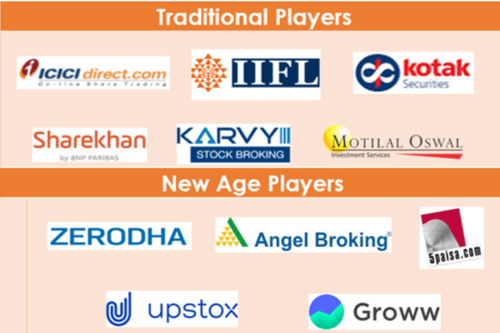
Opportunity for Institutional Investors - A Brokerage 2.0 that Solves for Success in the Market
While the number of demat accounts continues to rise, active clients across the National Stock Exchange (NSE) have been falling for seven consecutive months. The number of active accounts dropped 2.9 percent month-on-month to 3.4 crores in January 2023.
The broking industry has been going through a cyclical change over the last 3-5 years. A rapid increase in demat accounts was witnessed fuelled by the pandemic in FY21 and FY22. Subsequently, the slowdown in the increase of newer accounts, a reduction in the active client base in FY23, and expected muted numbers for FY24 have contributed to the cyclical change. Players who can come up with more innovative and customer-centric solutions to guide them toward the accurate principles of investing are expected to thrive through the cycle.
Revenues, Investments, and User Growth – A Snapshot
The Indian brokerage market generated a revenue of $4.67 Bn in FY23, expanding at a compound annual growth rate (CAGR) of ~13.73% between FY19 to FY23.
FY21 and FY22 saw a spur of activity in the discount brokerage space with companies like Groww, Raise, Upstox, and Fisdom, etc raising $754 Mn from the likes of Mirae Asset, Tiger Global, Ribbit Capital, Sequoia, IFC, etc.
The number of demat accounts as on Feb’23 was at 110 Mn (2) against 40.9 Mn (3) in March 2020. The primary reason for this phenomenal growth in numbers was due to covid induced demand and the changes in the industry during that period.
.png?width=906&height=215&name=646c408a1112007078194f42_Brokerage%20revenue%20growth%20(1).png)
What Contributed to this Double-Digit Growth?
1) SEBI's clarification on the know your customer (KYC) procedure and the usage of technology for KYC aided the online account opening process, which in turn helped in online client acquisition.
2) Indian Brokerage industry has been undergoing a structural shift from a percentage-led business model to a flat brokerage and subscription-based model.
3) Consumers had time and excess investable cash due to a reduction in overall expenditure due to the lockdown.
4) Most stocks in the Covid’19 market fall were extremely undervalued which motivated new investors to enter at cheaper levels.
5) Surplus liquidity-led bull run and FOMO driven by financial influencers led to a massive increase in market participation.
Share of top 5 digital brokers in incremental NSE active clients:
There has also been a steady growth in the share of the top 5 digital brokers due to better customer experience and user interface. The time taken to open an account with digital brokers is significantly lesser than the time required in a traditional setup. The top 5 digital brokers have constituted ~70% of the incremental active clients on NSE since March 2021.
Players in the market:
Most traditional players are full-stack service providers, facilitating customers with broking services, mutual fund products as well as distribution of third-party financial assets. New-age players who started as stand-alone brokerage platforms have also started moving in the direction of providing full-stack services with the likes of Zerodha, Groww, and Samco already holding AMC licenses and distributing newer products for better customer retention, ARPUs, and improved LTV/CAC.
Traditional Players New Age Players
.png?width=1054&height=277&name=646c51b5dc9c7d41f816ac34_new%20age%20brokerages%20(1).png)
Total Addressable Market:
As of March 2023, there are 11 crore demat accounts of which only 1.5 Cr are serious investors/traders who actively participate in the market. Out of them, 40 lakh accounts are those that earn their primary source of income from the stock market. Despite the huge base of customers, 90% of the trading volume is driven by ~10 -12% (~1.5Cr) of active investors.
The Blitzscaling Boomerang
‘Growth at all costs’ zeal during the covid era has led to unmitigated consequences on the business model, bottom-line as well as the top-line of such brokerage firms. Although the new-age brokerage firms have managed to capture the market in terms of a large investor base, the quality of such customers in terms of their revenue and LTV potential is very poor. Brokerages have a very high CAC, low ARPU, and low LTV and are finding it difficult to become profitable. Thus, it remains a challenge for them even in the medium term. The only notable exceptions are Zerodha and SAMCO which have a low CAC, high ARPU, and high LTV and are highly profitable. That’s the reason why some of the large brokers have started venturing into allied businesses like insurance and lending.
To top it off, the growth rate of new accounts added in FY23 has dropped by 50%. Players like Upstox have seen around 2 Mn(5) traders go inactive in the past year while 5Paisa, another popular brokerage lost 1 Mn(5) users. The incentive-driven approach to acquiring trading customers has backfired and people lured by glitzy IPL ads or through stock tips from social media channels have realized the dangers of investing irrationally and have quit the market. Even Zerodha lost nearly 200,000(5) traders during the same time.
Zerodha founder Nithin Kamath, “If correction in stock markets continues, Zerodha’s revenue may drop 30-40% in FY24”. (4)
The Inflection Point – Solving for Investor Access vs Investor Success
Another huge gap in the market is that existing players, both traditional and new-age, solve only for the “Access” but not for “success” of customers. The current set of players merely act as a facilitator and do not provide any value addition to the customer journey. Although the existing traditional players in the market provide customized recommendations to their top clientele through relationship managers, they are not 1) Scalable 2) Cost-effective, and 3) AI/ML led with insights into past trades and current portfolios.
“Investors don’t have access to basic insights like their trading history, and performance and don’t have responses to questions like returns at different points of time, the right price & time to buy a stock, extent of accurate leverage, win/loss rate, period over which the winner or loser should be held, frequency of wins/losses, trading style, the appropriate benchmark for comparison and how sectoral trends or regulatory changes are going to affect their portfolio.”
As a result, while the stock market has grown 250% over the last 3 years, 99% of the active investors could not beat the index. 90% of day traders lose 90% of their capital within 90 days, 85% of the market turnover is derivatives – indicates “speculative intent”, 60% of traders don’t use stop-losses or exit strategies and investors underperform by 5.8% vs mutual fund returns.
House View - Merisis
The first wave of innovation and tech solved for better accessibility and democratized access to the masses. This helped achieve a decent 8.1% demat penetration in 2023 Vs 1.7% in 2012.
The next stage of innovation will solve for value-added services to investors, helping them make more profitable investments. A proprietary tech-enabled research trading engine that provides customized inputs (based on proprietary trade information and real-time fundamental analysis) to investors with the help of AI/ML, is the need of the hour.
Companies focusing on solving for “Success” can unlock a $10bn+ opportunity in the next 5 years. VCs and PEs riding on this bet can make a huge impact on their portfolio by identifying the right companies to invest in and by entering the market at this inflection point.
Sources:
(1) NDTV, “Number Of Demat Accounts Rise 3% to 11 Crore In January” 14.02.23, Link
(2) TOI, “Demat accounts surge to 11 crores in January 2023 but active NSE accounts dip for seventh straight month”,15.02.23, Link
(3) TOI, “Demat accounts in India cross 10 crores for the first time”, 06.09.22, Link
(4) ET, “If a correction in stock markets continues, Zerodha’s revenue may drop 30-40% in FY24: CEO Nithin Kamath”, 16.04.23, Link
(5) ET, “New-age stock brokers’ bull run hits a bump”, 28.04.23, Link
How Merisis can help - Contact Us
Fintech companies are expected to play a vital role in increasing financial inclusion and digital adoption. The total addressable market for Indian fintech industry is expected to reach $2.1 Tn by 2030, with a CAGR of 18% from 2022. India has seen a significant rise in fintech investment, with about $35 billion invested across segments so far. The years 2021 and 2022 saw more than $19 billion of fintech funding and an addition of 18 fintech unicorns. Capitalizing on strong demographics, increasing digital adoption, maturing data ecosystem & infrastructure, and product expansion will help fintech companies accelerate financial inclusion within the regulatory guardrails.
The Fintech team at Merisis strives to identify trends early on and assist companies in the identified sub-segments with their growth plans. The team has extensive experience in fundraising and M&A transactions across the FinTech landscape having worked with companies in payments, distribution, lending, wealth tech and insurtech space.
Write to us on fintech@merisis.in



